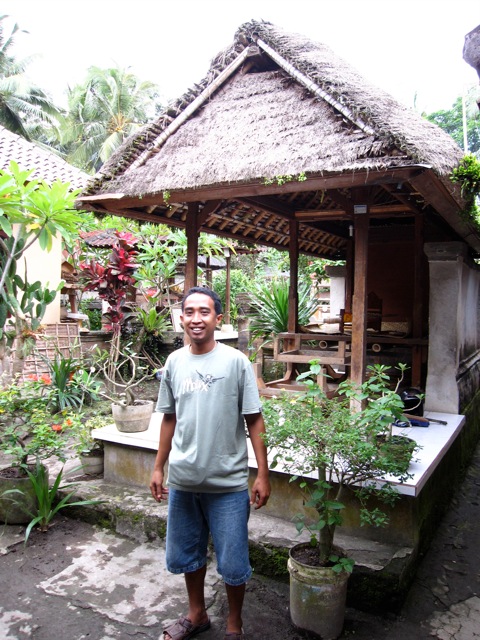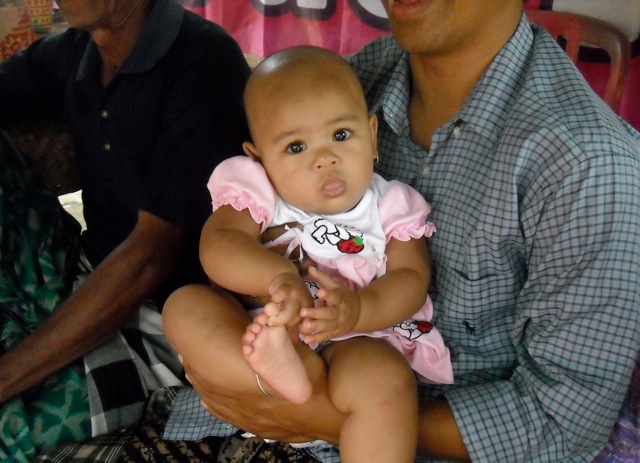Multigenerational Living in Paradise
While traveling in Bali, author Mike Litchfield writes an account of Balinese communal building traditions and how they connect wtih family values.

Bali has every shade of green on earth, balmy weather, and slender, good-looking people in constant motion. Anywhere you travel on the island’s snaky, two-lane mountain roads, it’s common to see a family of four or five straddling a motorcycle, arms and legs akimbo, threading their way among flatbed trucks overloaded with bricks and bags of cement, bicycles half-buried beneath bundles of thatch-grass, and knots of scruffy dun-colored dogs somehow not getting run over. The traffic petrified me, but the Balinese wove in and out as if choreographed, with nary an unkind word or angry gesture. When traffic gets really scary, a belief in reincarnation probably helps, too.
A peaceful gathering of 30 or 40 cousins
 |
 |
Thanks to mutual friends, my wife and I were invited to a family Christmas party. Our host, Billye, was a retired American who shared her big house on the edge of a rice field with a local builder, Legut, his wife Santi, and their three sons. Built in the lumbung style favored for granaries, the house has a thatched roof, large overhangs, an open floor plan, and an in-law unit on the ground floor.
By the time we got to the party, the joint was jumping. Tables sagged with platters of turkey and smoked pig, plates of exotic desserts and liter bottles of Bintang beer. In a riot of 30 or 40 kidssat Santa, resplendent in a red cap, green felt shoes and cutoff jeans, stuffing Christmas stockings. The kids were easy with each other—not a single yowl or snit the whole night—and my hunch that many of them were cousins was borne out a few days later when Legut took us for a tour of his family compound just down the road.
Family compounds and mutual help

Balinese compounds are modest cement block and stucco affairs, typically walled, with individual dwellings constructed around a central courtyard. Most contain four or five family units (a couple and their kids), each living in two or three small rooms; in total, 25 or 30 people. This is in-law housing to a T, because everyone is actually related.
Bali’s principal religion is an animistic brand of Hindu, so every compound has a family shrine to honor one’s ancestors and a number of other nooks where one can leave daily offerings, such as by the angkul-angkul or main gate. Mornings begin with prayers and offerings, which seem to recur throughout the day. One of the most endearing aspects of the Balinese is that while they are devout, they are not rigid: so long as one is sincere in intent, getting the details perfect isn’t as important. This focus on intent rather than form also explains why a devoutly Hindu land could enjoy a Christmas party with such gusto.
But back to building. When it’s time to add a new building—say, when a younger brother gets married and needs a kitchen—the work is invariably done by gotong royong (mutual help). As Legut explained it, 40 or 50 relatives show up over a period of days till the thing is done. A 10 ft. by 12 ft. kitchen for Legut and his new wife, for example, took five days to complete. In the spirit of gotong royong, there’s no money involved, just two meals a day for everyone who helps.
Speaking of eating, I should note that while each family in the compound has its own small kitchen, as a rule families don’t eat together. The women typically prepare a rice meal in the morning and whenever someone is hungry during the day they just pop in and grab a bowl. Towards the back of the compound is a small garden plot or a fenced area in which to collectively raise pigs, chickens, and perhaps a cow. Most compounds have city water and are modestly wired, primarily to power TVs or, these days, charge cell phones.
A lifelong connection

Intimately involved with each other’s lives, the people of Bali know who they are, and two details of their culture are particularly telling. First, after a child is born, its placenta is buried under the stone that serves as the family’s doorstep, so that an individual’s soul can always find its way home. Second, a child’s feet are not allowed to touch the ground until he or she is 105 days old. Consequently, almost everyone in the banjar (village) will have a hand in holding and carrying that child till its feet first stand on the earth.
Given that awareness of the interconnectedness of life, perhaps it was only natural that when Legut and Billye met and became fast friends, that Legut should help Billye find land near his banjar and help build his home and shortly after that—when he and Santi married and began raising a family—that all of them should share a roof.
Create Your Own In-Law!
If you’re interested in second units, In-laws, Outlaws and Granny Flats: Your Guide to Turning One House into Two Homes offers a trove of case histories, design details, and practical tips. The Library Journal named it one of the 10 Best Design Books for 2011.
For those doing (or overseeing) the work, Renovation 5th Edition, (May, 2019) will be a great companion. Its 656 pages cover home renovation from start to finish and contain lifetimes of practical, field-tested techniques that professional builders shared with me over a 40-year period. Happy building!
© Michael Litchfield 2019
Fine Homebuilding Recommended Products
Fine Homebuilding receives a commission for items purchased through links on this site, including Amazon Associates and other affiliate advertising programs.

The New Carbon Architecture: Building to Cool the Climate

Homebody: A Guide to Creating Spaces You Never Want to Leave

Pretty Good House

























View Comments
We have much to learn from these peaceful and loving people, especially when it comes to living together harmoniously. Our western society suffers from so much isolation particularly during times of celebration or loss. If you visit Bali you can see it in their faces and feel it in the air. The people are happy and connected no matter what their economic situation.